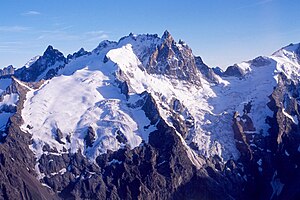La Meije
| La Meije | ||
|---|---|---|
|
The Meije with the Grand Pic |
||
| height | 3983 m | |
| location | France | |
| Mountains | Pelvoux , Western Alps | |
| Coordinates | 45 ° 0 ′ 0 ″ N , 6 ° 17 ′ 59 ″ E | |
|
|
||
| First ascent | August 16, 1877 by the French Emmanuel Boileau de Castelnau and father and son Pierre Gaspard | |
| Normal way | Glaciated high tour from the north side | |
|
Aerial view from the north of the Meije massif |
||
La Meije is a 3983 meter high mountain in the Pelvoux in the Dauphiné Alps , which are part of the French Western Alps . Surrounded by large glaciers in the north and east , the mountain, with its granite wall rising 800 m above the Etançon glacier, shows a rather rocky shape from the south . Although the Meije just missed the 4,000 meter mark and is clearly dominated by the neighboring Barre des Écrins, it is probably the most famous mountain in France after Mont Blanc .
The name of the mountain is derived from the Provencal Meidjo or Meidjour (= noon). In terms of meaning, the Meije is nothing more than another Aiguille du Midi .
summit
- Summit of the central ridge
- Grand Pic de la Meije or Pic Occidentale , 3983 m
- Pic Central or Doigt de Dieu , 3970 m
- Pic Oriental , 3891 m
- Pic du Glacier Carré , 3862 m
- Le Grand Doigt , 3764 m
- North upstream peaks
- Bec de l'Homme , 3454 m
- Rocher de l'Aigle , 3450 m
- Serret du Savon , 3571 m
The Meije is separated from the Massif des Râteau in the west by the Brèche de la Meije, and from the Pic Gaspard in the southeast by the Brèche Maximin Gaspard .
Mountaineering
The Meije is considered to be one of the most difficult high peaks in the Alps. The difficulty of its ascent also exceeds that of the Aiguille Verte , which is considered to be one of the most demanding four-thousand-meter peaks in the Alps. The Meije has an exciting climbing history, during which the Grand Pic was climbed after several failed attempts on August 16, 1877 by Emmanuel Boileau de Castelnau and the guides father and son Pierre Gaspard . The successful rope team climbed the Promontoire ridge to the left of the south face to Glacier le Carré , then the south-west face of the Grand Pic and reached the summit by changing over to the north face over the last few meters. This made the Meije one of the few French high peaks that local guides were the first to climb .
Pic Central, which is only a few meters lower at 3970 m, was first climbed on June 28, 1870 by WAB Coolidge , his aunt Meta Brevoort , Ch. Gertsch and Christian and Ulrich Almer .
Ludwig Purtscheller set another alpine milestone on the Meije with the brothers Emil and Otto Zsigmondy . On July 27, 1885 they made the first longitudinal traverse of the summit ridge from Pic Central to Grand Pic. A few days later, on August 6, 1885, Dr. Emil Zsigmondy trying to climb the Meije south face to death. The grave of this famous Austrian mountaineer can be visited in the Saint-Christophe-en-Oisans cemetery on the access road to La Bérarde , the alpinist center on the south side of the Meije. The Meije was also fatal for the Munich mountaineer Emil Solleder , who is considered one of the best climbers of his time. On July 27, 1931, he fell to his death while crossing the summit ridge 600 meters over the south face when a rappelling block could not withstand the load and broke out.
The south face was first climbed in 1912 by the South Tyroleans Angelo Dibona and Luigi Rizzi together with the two Viennese Guido and Max Mayer.
The ski resort La Grave on the north and La Bérarde on the south side of the Meije are nearby bases for mountaineers and tourists.
Individual evidence
- ↑ Carl Frey: The Meije and its story , published in the monthly journal of the Swiss Alpine Club Die Alpen - Les Alpes - Le Alpi , Bern 1925, p. 96
- ↑ Eberlein describes the Meije as "undoubtedly the most difficult great mountain in the Alps", cf. Hartmut Eberlein, Dauphiné area guide , Bergverlag Rother , Munich 1988, page 88 ISBN 3-7633-3414-9 .
- ↑ According to Eberlein, the Aiguille Verte is "rightly considered the most difficult four-thousand-meter peak in the Alps to climb", cf. Hartmut Eberlein, Area Leader Mont Blanc Group , 9th edition, Bergverlag Rother, Munich 2000, page 357 ISBN 3-7633-2414-3 . However, he rates the difficulties on the Meije higher than on the normal routes of all four thousand meter peaks, cf. Area Leader Dauphiné , page 16. At most the Drus and Grépon have comparable difficulties (ibid).
- ↑ Ludwig Purtscheller , About rock and firn. Western Alps and trips outside of Europe. , Alpine Klassiker Volume 8, Verlag J. Berg , Munich 1987, page 125f. ISBN 3-7654-2150-2 .
gallery
The Meije from the Col du Lautaret
Web links
- La Meije on Summitpost (English)




